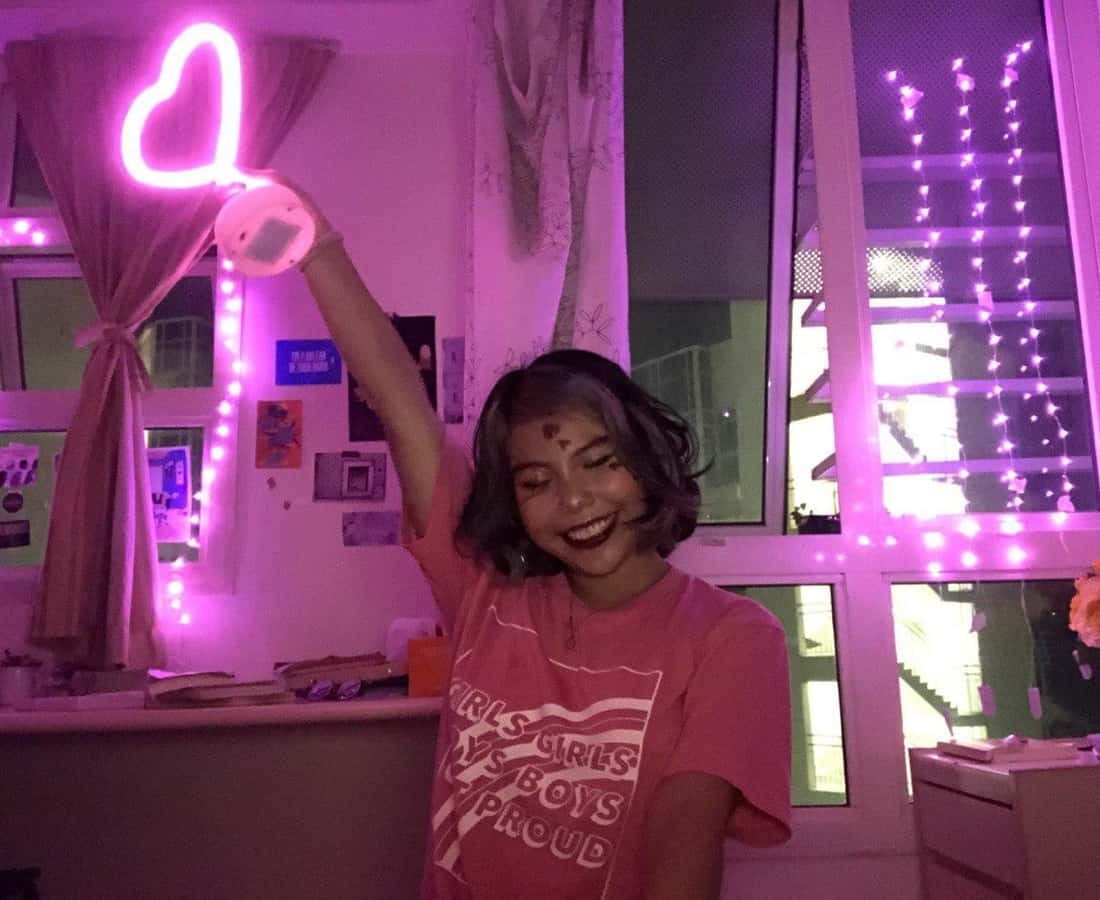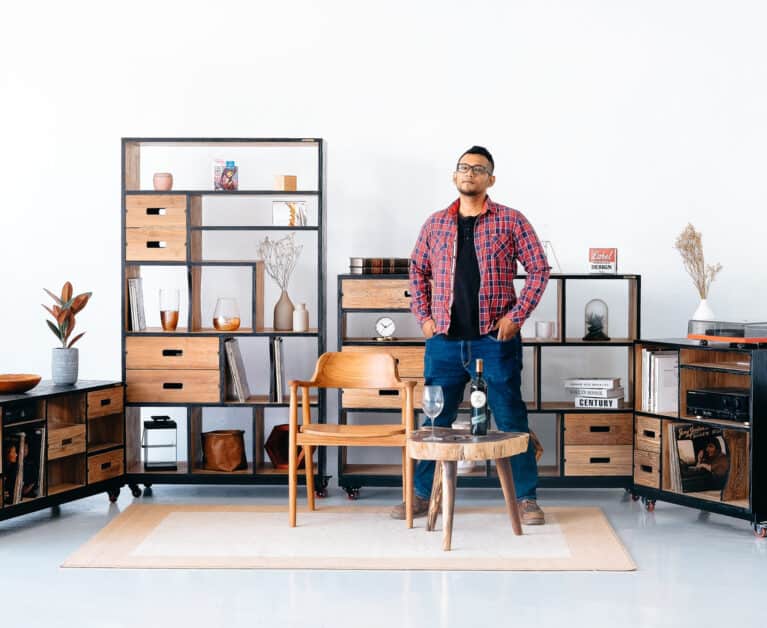Eye Candy: We Chat with Artist and Queer Activist Irie Aman

PUBLISHED June 26th, 2020 05:00 am
Art is at the heart of Irie Aman‘s life, and they’re constantly in the thick of various intriguing projects. Irie is the Editor-in-Chief at independent zine The Local Rebel, and since last year, they’ve been giving artists a voice as Event Manager at a monthly open mic night, dink collective. In these pandemic times, this 23-year-old dynamo has launched mental health workshops to help others cope in lockdown, and is in the midst of raising funds for vulnerable communities.
In this edition of Eye Candy, Irie shares about how art has impacted their life, the effects of COVID-19 on the queer community, and their fave bubble tea drink.
How did you get into creating zines, and how did being editor for The Local Rebel come about?
Funnily enough, I had no idea what a zine was when I first started out! I just wanted to create an educational resource that was accessible for a younger audience, and I thought the magazine format was one that could balance both information and art. I was part of the founding team for The Local Rebel, and began as Head Writer.
When the then-Editor in Chief needed someone to cover them as they stepped down, they asked me to take over. When I learnt about the history of zines and what their role was, I realised we had accidentally created something that could be both magazine and zine. I’ve since created zines about and for people I love, but nothing yet that I’ve felt ready to put out for public consumption.
What’s your work process like when creating an issue for The Local Rebel?

I was 18 when I was first put in charge of The Local Rebel. I had no idea what a work process was, and I still can’t really tell you: everything we’ve done came from scratch and lots of frantic Googling.
I am very, very lucky to have a fantastic team of designers and writers whom I trust and who trust me. Firstly, we communicate to one another and figure out what’s our vision for the zine. Next, we break it down into themes/topics to explore, then figure out what’s actionable. We do both open calls and source from creators we know, so our zine is a labour of love from all sides! There’s a lot of back-and-forth as we try to make each article shine.
You’re a very creative person – other than working on TLR, you also write poetry and practice watercolour. How has art impacted your life?
I think writing was the first way I realized I could explore who I was, but watercolours were how I fell in love with the world and all its intricacies. I didn’t gravitate to art so much as I gravitated to colour, and that started with dyeing my hair way before I picked up a brush! Art has nurtured me and given me so much insight, and it’s also been where I’ve found my strongest communities.
Not to mention, there’s no shortage of queer people in the art scene, which I’m really grateful for. I’m part of a writing collective, Stop At Bad End Rhymes (SABER), who’ve taught me so much about poetry – we have monthly workshops to critique one another’s poetry. dink is my other pillar of strength, and a testament to how lovely art folks are!
Art has also allowed me to give back: I helped start Nine of Funds, which is a tarot and art collective aiming to raise funds for various fundraisers (Wares Mutual Aid, HOME, and Sayoni among them), in exchange for tarot readings and tarot-inspired art.
We know you’re very passionate about bubble tea. What’s your usual go-to drink?
This is a really hard one. Ever since starting my bubble tea review account, @lgbbt.reviews, I’ve tried to go out of my comfort zone with each drink, but Liho’s Strawberry Foam Oolong Tea is magnificent and affordable.
Last year, you started work at dink collective. How has your experience working with various artists been?
dink is a monthly open mic night, that’s now back at Blu Jaz! It’s radiant, dynamic, and ephemeral. I learn so much from each artist, both on and offstage, whether it’s their energy, their opinions, or how they’ve crafted a certain lyric to just hit right. The community and my team are so full of passion and love for art and you can really see that manifest. It’s my honour to be cheering them on!
You spoke at Pink Dot 2019, and you’ve also participated in the Pink Dot 2020’s campaign video. How different is it celebrating Pink Dot from home this year?

I think we have to remember that queer community is what we make it, and it’s not just a single day of celebration: it’s tending to our people everyday we can. Pink Dot is a wonderful day for all that love to come together at its peak, but we can also learn a lot from the communities that continue to build on each other even when the glitz and glamour has faded. Celebrating from home can be just as wonderful if you reach out to the people you do know. How can you show up for them? How can you give them your love and joy, even while apart?
How do you think the COVID-19 pandemic has affected the queer community in Singapore?
COVID-19 has definitely been tough on us. Crises disproportionately impact vulnerable groups and amplify pre-existing inequalities. Even with different schemes out there, queer folk tend to fall through the cracks. What’s more, not everyone can quarantine in an environment that is safe for them and mental health has become a really big concern.
But as with every crisis, there is community: and queer people coming together to rally each other on, whether it’s through daily Queer Zine Fest pajama parties on Instagram, Your Head Lah mutual aid, monthly dink Zoom sessions, or the Sayoni Relief & Resilience Fund. QUASA and Nine of Funds are also queer-led collectives that arose during this period, and that really gives me hope.
During lockdown, you started up your own mental health workshops with others online. What inspired you to do so, and how have these sessions been?
I was originally tasked to do them for QUASA, a Queer Muslim peer support and resource sharing collective. We were actually slated to launch them after circuit breaker, but I felt so strongly for queer folks, many of whom were trapped at home with homophobic families, especially queer Muslims quarantining during Ramadan.
After a successful first workshop, I asked myself why I wasn’t able to replicate them for a larger audience, since I had the time and energy. Singapore has always neglected mental health needs, and there is a large access gap I wanted to bridge. So these workshops were created to help people process living during circuit breaker, learn coping skills, and find community.
You’re also very experimental with make-up. What does makeup mean to you and how does it affect your personal style? What products do you swear by?
I think makeup empowers me in that it always pushes the envelope. Before I do something experimental I feel a little apprehensive: but when it’s done I feel invincible and want to parade it around and incorporate it more into my everyday looks, and I wonder why I was scared!
I think editorial makeup is a wonderful way to reclaim it back from its commodification, and it helps me return to my queer roots. Recently, I drew on my face (inspired by an Instagram filter) a scorpion and crescents in a manner that was very gothic, and I started questioning why I hadn’t tried dressing more witch-like. I think that’s how expansive makeup can be, if you let yourself experiment!
For this reason, I love a good eyeliner (Sephora or Maybelline have affordable options), and Juvia’s Place The Masquerade eyeshadow palette is incredibly pigmented and versatile.
You seem to love travelling. Once you can travel safely again, where would you want to go?

I would love to visit Cambodia or Japan with my loved ones!

